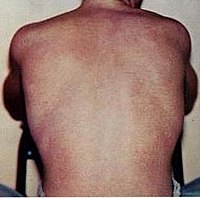
Photo from wikipedia
Background: The World Health Organization in 2009 revised categories of dengue fever severity into classes A, B, and C based on the presence or absence of warning signs. The quantum… Click to show full abstract
Background: The World Health Organization in 2009 revised categories of dengue fever severity into classes A, B, and C based on the presence or absence of warning signs. The quantum of oral and intravenous fluids (IVF) in hospitalised patients with Group B (warning signs) have, to our knowledge, not been studied. Oral fluids in hospitalised patients and monitoring administration with the help of patients’ relatives have not been assessed. Methods: Consecutive patients with dengue fever and warning signs were studied for 48 hours after hospitalisation. Patients were asked to consume 4-5 l of fluids. Maintenance and bolus IVF were administered depending upon the presence of compensated or hypotensive shock. Intake and urinary output were monitored by the patient’s attendant. Total fluids (oral and intravenous) were divided by a number of anthropometric measurements. Significance of compensated and hypotensive shock, thrombocytopenia and 20% change in haematocrit, bleeding episodes and the need for transfusions, and organ impairment were considered in relation to the total amount of fluids received daily. Results: In total, 41 patients were studied. Patients with obesity and hypotensive shock received significantly more fluids on Day 1; taller patients and those with tachycardia, higher haematocrit and elevated creatine kinase correspondingly received more on Day 2. Hypotensive shock was significantly correlated with fluids/BSA and fluids/weight, while laboratory parameters correlated most strongly with fluids/BMI. Conclusions: Most adults with dengue and warning signs seem to require >100 ml/kg/day of fluids during their stay. Advising a similar amount of fluids at home during epidemics may further reduce the need for admissions. Participation of patients and their relatives in the bedside management of fluid administration may go a long way in preventing morbidity and mortality. Adults probably need a better anthropometric measurement to decide on the quantum of fluids to be given.
Journal Title: F1000Research
Year Published: 2019
Link to full text (if available)
Share on Social Media: Sign Up to like & get
recommendations!